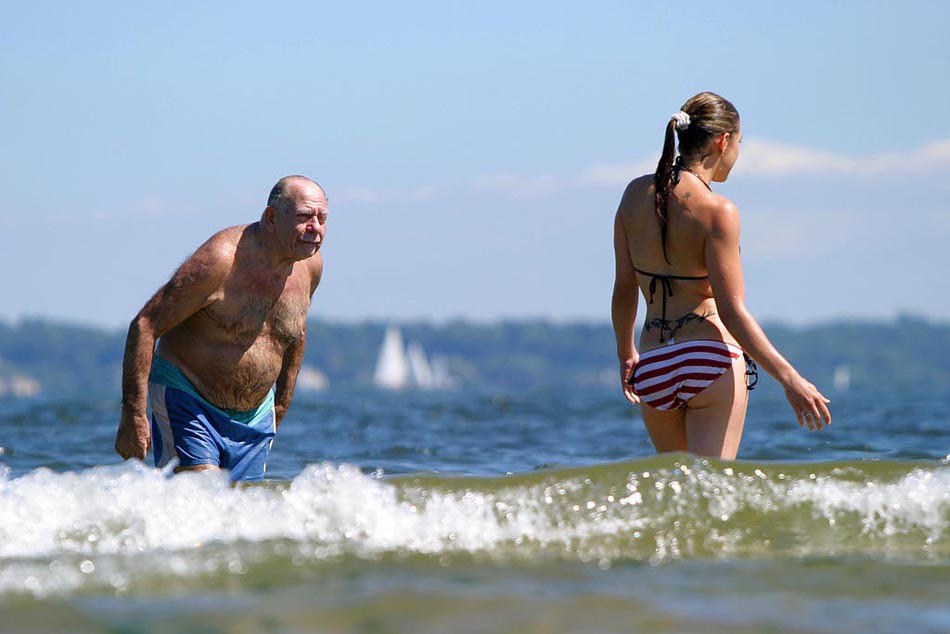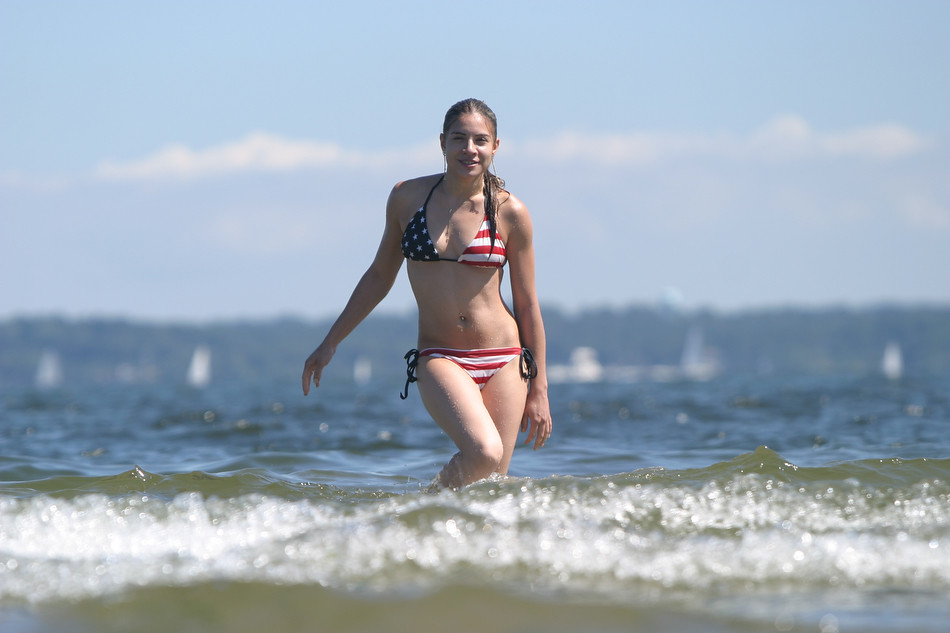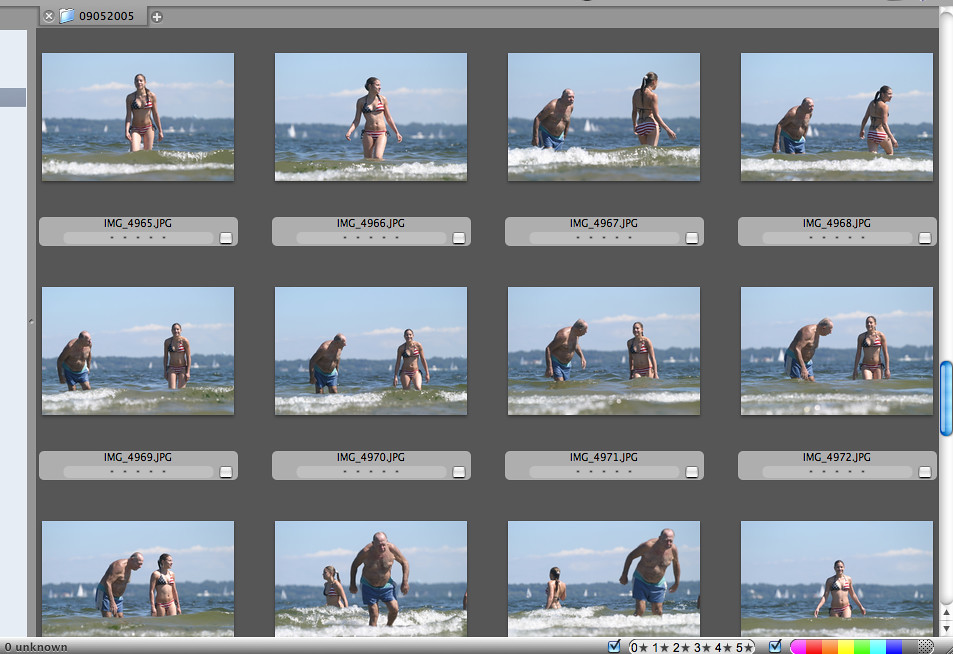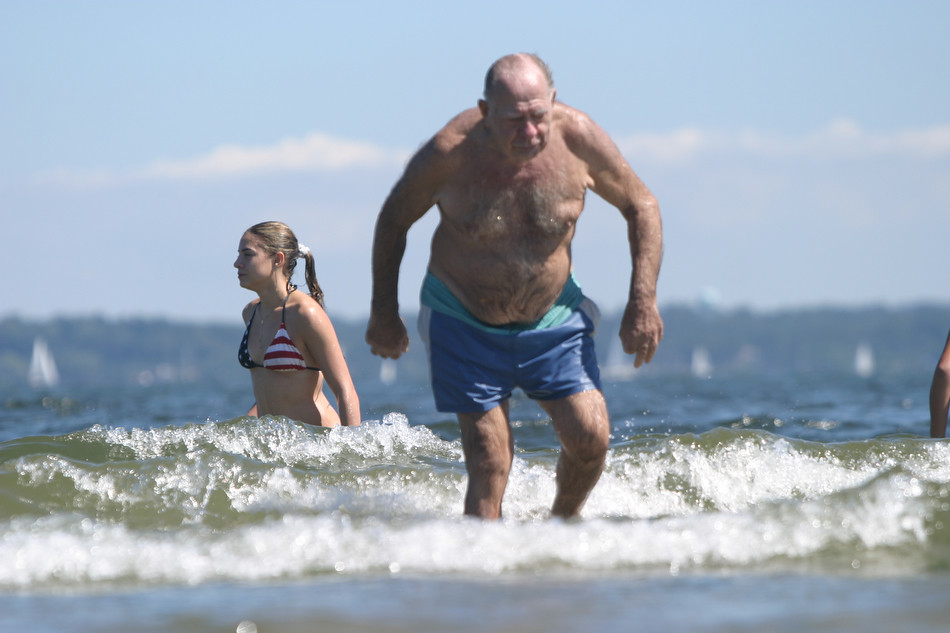Spotlight on Robert Sabo
Jun 1, 2012

TID:
This photo makes me laugh! Bob, can you give us some background as to how you happened upon this situation?
BOB:
It was Labor Day weekend, and I wanted to make an “end of summer” picture. I had a few hours of free time before heading off to the night matches at the US Open. Orchard Beach was on my way to the tennis center in Flushing, so I went there because it was a fast in-and-out. I thought I could bump into more picture possibilities more quickly on foot on the beach rather than driving around. The beach was surely a cliché, but I wanted to capitalize on my time.
TID:
There is so much to see in NYC but after so many years there how do you mentally keep a fresh eye?
BOB:
At the core of what I am trying to accomplish with my photography is to show others the beauty that exists in their own everyday lives. Beauty they would otherwise pass without taking notice. Ideally, I'd prefer to reveal this beauty with orderly, pleasing compositions and metaphor. In this way, the viewer not only sees a reflection of his or her own life and its beauty but, if done well, also is an active participant in its revelation. That's what I am trying to do. It’s not always that easy.
Sometimes I get too caught up in shape and form and miss the obvious. When I find myself stuck, my pictures look stale, or I’m just not in the moment, I have at times made little exercises for myself. These vary greatly but here are a few examples: I remember a day when I just couldn't find a photo, so I convinced myself that there was a good photo on this one city block, and I just HAD to find it. I didn't allow myself to cross a street, and I had to remain on the sidewalk on that one city block. I may have circled that block for two hours before I made a decent picture but the exercise forced me to focus and really see. Another thing, while silly but helpful, was to write one or two word concepts on tiny slips of paper, fold them up and pick one out of a bowl each morning before heading off. I can't remember them all but some were as simple as “LOOK UP,” “SHADOWS,” ”THE INVISIBLE,” “LINES” and “FRAMES.” Maybe the success of these exercises was simply having a starting point that wasn't too rigid.

TID:
How many frames of a situation are you expected to submit at The (NY) Daily News per assignment? Are you expected to file keeping multi-use in mind (print and online)?
BOB:
I don't know if there are any hard and fast rules but I think the expectation is to provide the paper with some flexibility vertically and horizontally and maybe some lefts and rights too. Keep in mind, a bad photo shot 20 different ways won't make the paper. Our photo desk picture editors and assignment editors are very good at what they do. They keep us informed, updated and in-the-know but try not to interfere with the on-the-ground news gathering. I get my assignment and then go about the task of pursuing good pictures. It’s my experience that when photographers spend their day jabber jawing with the photo desk -- trying to nail down exactly what the editor has in mind for an assignment – they are setting themselves up for failure. Too much preconceiving usually ends with bad pictures and since we don't run bad pictures – it’s not the best plan.
We rarely run comprehensive picture stories or essays in the print edition but, at this very moment, we are in the process of opening up more space online to showcase a wider take. This is promising because we hope it will provide the reader with a more extensive photo report. It can also be a tool to tell stories without having to cram so much information into one frame. Shooting for a daily tabloid newspaper can sometimes be a struggle to pursue pictures in a way that pleases both my internal photo compulsion and the needs of the newspaper. I try very hard not to separate these pursuits. When I do that, shoot this-kinda-picture for them and that-kinda-picture for me – I end up with two sets of bad pictures. Trying to please two masters at the same time just doesn't work.
Lately, I've been shooting in a way that pleases me; then I send a loose edit and let the picture desk sort it out. We call ourselves a newspaper – the key word being “new.” Concentrating too much on what the reader said they wanted yesterday or last week or from a survey, focus group or an editor's expectation based on something he or she had previously seen, in my mind, would produce an 'olds' paper. I guess it's a common business strategy as profits decline to look at what worked well in the past and clone it into everything you do in the future but I'm not sure that works in the newspaper business. Even if it does work in the short term, I don't believe it is sustainable, certainly not for photography because it heads straight to boring “I've seen that before” images.

Photography has been evolving and arguably improving, since Niépce made that first frame out his window in 1825. Advances in technology, coupled with lessons learned by simply witnessing the great works by the masters of our past pushes the work forward. It is not my intention here to insult these old masters, but I don't believe David Douglas Duncan would be known today if his images were made in the way that Mathew Brady made his and, by that same reasoning, I think some of Neil Leifer's photography would be rejected by today's sports picture editors. That's not to say that these images were not great work – they 'were' and still 'are' - because they are viewed from within a framework of their place in the past. So I am left to ask: where are we headed? It's a common lament that we live in an image culture. If we are the image makers of our generation – what is next? What is new? It just can't be more celebrity pictures! It just can't! I truly want to believe at least, that this image culture wants and craves more sophisticated imagery.
That's what I set out to do everyday and almost always fail. I see these images, these next generation photos, being made by photographers like Mario Tama, Yuri Kozyrev, Daniel Berehulak, Mike Appleton, Paolo Pellegrin and Nina Berman. Some of these new images have such complex structures while still remaining held within an order. These new images often utilize more complex and sophisticated structures, where a host of active, and what appears to be uncontrollable or chaotic elements, work together in concert to perfectly complete the composition. If art is, as I believe it is, at its core simply finding order within the chaos – then these photographers have tapped into the new art. Instead of heading out each day to make pictures to satisfy an editor, I am trying to make this my goal. I can't also help but think that having all this swimming around in my head while making frames could be getting in the way, too.
TID:
Now back to the main image. Can you tell us what led up to the moment and what was going on in your mind when you made the image?

BOB:
I walked up and down the beach, but all I really saw were clichés. Then I saw this young girl you see here, wearing a patriotic bikini, running, splashing into the water. She really had it all: youthful zest, beauty, bikini and innocence all mixed in with a uniquely Bronx look. My hesitation prevented me from making the picture of her running into the water. I didn't want to appear like the pervy guy at the beach taking pictures, so I thought it would be better to ask first. I approached her in the water, introduced myself and asked if I could make some pictures. She was thrilled with the possibility of being in The Daily News and began posing for me as one would do if they were going to be in the Sports Illustrated Swimsuit Calendar. Between poses she would ask, “What do you want me to do?” I had no easy answer for that question.
The beautiful, end-of-summer, last run into the surf photo was gone and replaced by a disappointing, one-dimensional, gratuitous cheesecake photo. I made some frames and prepared to move on when I saw a hunched, old man lumbering slowly as he approached from the left. He had the look of stern judgment in his eyes as if to say, “Why is this creepy photographer disturbing my dip in the water with his suggestive photography!” I recomposed, moved the focus preset to the right, locked her in and prepared to make my own beach version of Weegee's “The Critic” masterpiece. If I could somehow get them on the same plane of focus, I could possibly manage the photograph to have the same shape, balance and form as a finely crafted Garry Winogrand picture. It didn't go down that way. He got past her and took a good long drink-of-water look at her as he made his way deliberately through my frame.

TID:
How do you handle getting the subjects' names in a situation like this, which without context, might be misunderstood? Do you know if the man ever saw the photo? If so, do you know what his reaction was?
BOB:
The man walked through the frame and went and sat in his beach chair behind us. I realized I had a nice picture, so I walked over to him, introduced myself and said, “Hi. I got a nice picture of you looking at that girl a few moments ago. Can I get your name?” He chuckled, saw the humor in it and gave me his name. We want to believe that young people are more "with it" and free-spirited, but my experience is that young people are a bit more uptight about how they are being perceived. Older people aren't so easily offended and have more experience at ferreting out the deceiver. I don't know if he ever saw the photo. It ran in The Daily News the next day so I assume he did. I don't know what his reaction was, but I would be surprised to hear that he was disappointed.

TID:
What do you do if you sense in a public situation people might not want you taking their picture?
BOB:
It really depends on the picture. I can't imagine most people want their image made in a perp walk situation, but the newsworthiness of it obviously takes precedence. In pursuit of street and feature photography it changes a bit, at least for me. If the photo involves a child or young teenager, I tend to seek permission before I begin shooting. This almost always interferes with the photo I wanted but can, on occasion, work its way back to a good photo or develop into a better unforeseeable photo opportunity. That's what happened with this picture. For the most part, I really don't want to ask permission to make photos but if I do, I abide by the subject's decision. I've seen photographers ask permission and then go on to make pictures even after the subject said no. It really seems fraudulent and dishonest to ask if you aren't going to honor the response.
I should mention here that I don't feel what I do is harmful. I try to be kind, straightforward and honest with my subjects and I think that may play a part in the success I have with this kind of photography. I also get great joy out of making good pictures; I think some of that joy may be shared or contagious with the subject. Maybe that encourages them to take part.

TID:
Have you learned to adapt your approach when taking feature pictures?
BOB:
Maybe. I try to not be aggressive and over anxious these days. When you pursue a picture like a cat, your subjects behave like mice – they flee. It’s better when the pursuit is more like fishing.
TID:
Was there anything that surprised you about the experience?
BOB:
I am always surprised when I make a good picture. It’s like the fabric of the universe and the lattice of coincidence are colliding.
TID:
How does this image make you feel when you look at it now?
BOB:
Well, after one of your previous questions, at this very moment, my mind wanders to whether the man in the photo got an earful of grief from his wife when the picture ran in the paper that day. Or how the girl felt about being the perceived recipient of a lecherous man's gaze. I feel a sense of kinship with my subjects and wouldn't want them to feel they were hoodwinked into being in one of my frames.
TID:
Can you share some advice with others who want to do street photography?
BOB:
You don't capture these kinds of images by hanging out in the office or cruising the internet at Starbucks. Like I said earlier, it’s a bit like fishing. You have to have your hook in the water to catch a fish and it often takes time. You may have to be immersed in it for hours and hours before these kinds of picture possibilities present themselves. Also, be kind, have regard for your subjects, and enjoy it. Really. When I am filled with anger, self-doubt or pity, I never make good pictures. I encourage myself to think of picture-making as the beginning and end of it all. It keeps me in the present and better prepared to witness beauty when it’s revealed. If my mind is consumed by the next assignment, how my photos were played in that day's paper, or my rank among my piers – my pictures suffer.

TID:
Any final thoughts?
BOB:
Most photography conversations these days are dominated by technology or consumed by the recent perils of our industry. It’s refreshing to see what's happening here at The Image Deconstructed where there is at last a dialogue about what is happening inside the frame. Photography is not dead – not by a long shot. It may be evolving in a way that some of us don't feel safe (and I don't mean video) but it is here to stay. If I have advice for photographers it would be to do what every successful photographer in history did: make great pictures. Have a conversation about pictures and not pixels. Seek out great pictures, understand their contents and their contexts and then go out and make your own.
BIO:

Next week we'll take a look at this image by Travis Dove:

If you have any suggestions or if you want to interview someone for the blog, contact Ross Taylor or Logan Mock-Bunting.